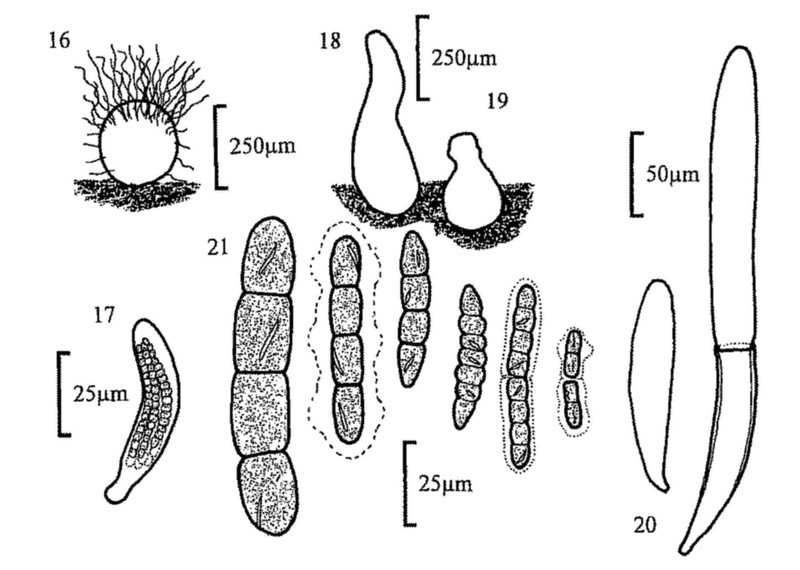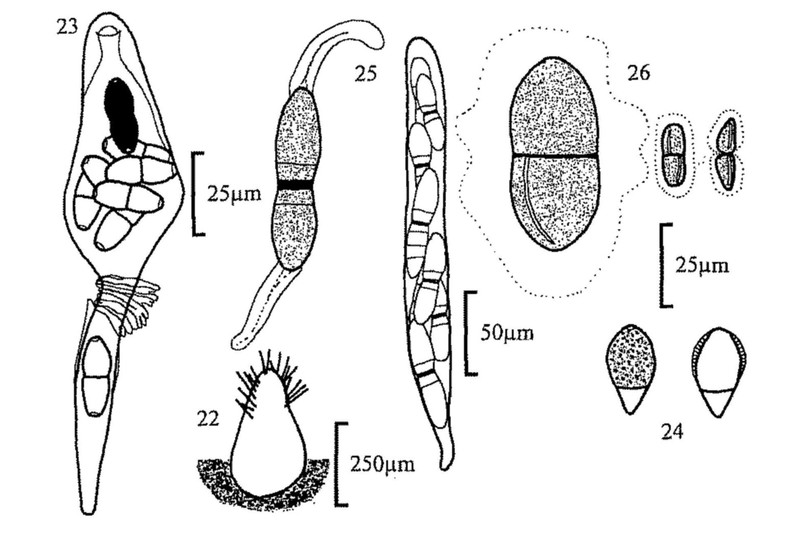|
54(53)
|
Spores ellipsoid, sometimes inequilaterally flattened, 44-54 × 22-30µm, with 1 apical germ pore, caudae not swelling in water. Perithecium usually with lateral tufts of agglutinated hairs
up to 550µm long.
|
|
Arnium arizonense
|
|
-
|
Spores evenly ellipsoid-fusiform, 31-55 × 18-25µm, with germ pore at each end, caudae covering germ pores, 35-60 × 7-11µm, but rupturing and swelling to up to 130 × 50µm, and becoming
diffuse and irregular. Perithecial neck covered with rigid hairs up to 190 × 2.5µm.
|
|
Arnium hirtum
|
|
55(53)
|
Perithecial neck distinctly setose with rigid hairs.
|
56
|
|
-
|
Perithecial neck without setae.
|
57
|
|
56(55)
|
Spores evenly ellipsoid-fusiform, 31-55 × 18-25µm, with germ pore at each end, caudae covering germ pores, 35-60 × 7-11µm, but rupturing and swelling up to 130 × 50µm, and becoming
diffuse and irregular. Perithecial neck covered with rigid hairs up to 190 × 2.5µm.
|
|
Arnium hirtum
|
|
-
|
Spores slightly inequilateral, 35-43 × 17-23µm, caudae 50-75 × 5-8µm, not covering germ pores. Perithecial neck with brown hairs up to 250µm long.
|
|
Arnium cervinum
|
|
57(55)
|
Perithecia covered with a dense tomentum of septate flexuous hairs. Spores mostly longer than 45µm. Only occasionally fimicolous.
|
58
|
|
-
|
Perithecia without a tomentum. Spores up to 45µm.
|
59
|
|
58(57)
|
Spores (40)45-54 × 25-35µm, uniseriate. Tomentum pale or grayish.
|
|
Arnium olerum
|
|
-
|
Spores 47-70 x 20-30µm, biseriate above. Tomentum olivaceous brown.
|
|
Arnium tomentosum
|
|
59(57)
|
Spores somewhat inequilateral, rounded below, pointed above, 31-40 × 18-24µm, caudae 50-120 × 6-10µm, with 1 apical germ pore not covered by cauda.
|
|
Arnium caballinum
|
|
-
|
Spores equilateral, 36-44 × 20-23µm, caudae 50-80 × 6-8µm, covering germ pores.
|
|
Arnium mendax
|
|
60(51)
|
Perithecia with scales at the neck, composed of inflated and agglutinated cells (fig. 27, S. conicum).
|
|
(Schizothecium) 61
|
|
-
|
Perithecia setose or hairy at the neck, but not with inflated cells, or neck black but almost hairless.
|
|
(Podospora) 70
|

